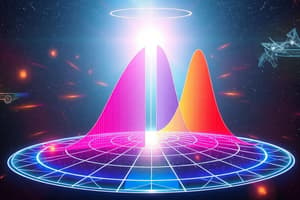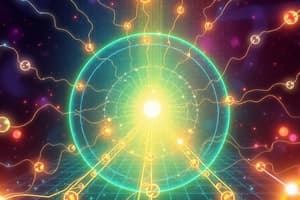Podcast
Questions and Answers
What replaces Cathode Ray Tubes in modern displays?
What replaces Cathode Ray Tubes in modern displays?
- OLED Screens
- Plasma Displays
- LED Displays
- Liquid Crystal Displays (correct)
What is defined as the energy gap between the valence band and the conduction band?
What is defined as the energy gap between the valence band and the conduction band?
- Energy Gap (correct)
- Conduction Gap
- Valence Band Gap
- Forbidden Energy Zone
In a semiconductor, how do electrons behave in the conduction band?
In a semiconductor, how do electrons behave in the conduction band?
- They are tightly bound within the atoms.
- They can only move at absolute zero temperature.
- They cannot transition back to the valence band.
- They are free to move and contribute to electrical current. (correct)
What characterizes an insulator in terms of energy bands?
What characterizes an insulator in terms of energy bands?
What does the term 'forbidden energy gap' refer to?
What does the term 'forbidden energy gap' refer to?
How does temperature affect the conductivity of semiconductors?
How does temperature affect the conductivity of semiconductors?
Which statement about the conduction band in semiconductors is correct?
Which statement about the conduction band in semiconductors is correct?
What is meant by the term 'valence band'?
What is meant by the term 'valence band'?
Which of the following describes metals in terms of energy bands?
Which of the following describes metals in terms of energy bands?
What does Eg represent in the context of semiconductors?
What does Eg represent in the context of semiconductors?
What is the primary function of rectifiers?
What is the primary function of rectifiers?
What is the output frequency of full-wave rectifiers in relation to the input frequency?
What is the output frequency of full-wave rectifiers in relation to the input frequency?
What is the characteristic of Zener diodes regarding current?
What is the characteristic of Zener diodes regarding current?
What type of biasing do photodiodes typically operate under?
What type of biasing do photodiodes typically operate under?
What is the main difference between LEDs and regular junction diodes?
What is the main difference between LEDs and regular junction diodes?
What does a solar cell aim to convert?
What does a solar cell aim to convert?
In the formula for normal voltage ($V_n = \frac{kT}{q}$), which variable represents the charge?
In the formula for normal voltage ($V_n = \frac{kT}{q}$), which variable represents the charge?
What does the reverse saturation current (I) depend on according to the formula $I = I_0 e^{\frac{V}{kT}}$?
What does the reverse saturation current (I) depend on according to the formula $I = I_0 e^{\frac{V}{kT}}$?
What is the formula for current density (J) for electrons?
What is the formula for current density (J) for electrons?
Which materials are used in the fabrication of LEDs?
Which materials are used in the fabrication of LEDs?
What type of impurity creates n-type semiconductors?
What type of impurity creates n-type semiconductors?
In which type of semiconductor are holes the majority carriers?
In which type of semiconductor are holes the majority carriers?
What happens to the effective barrier potential in reverse bias?
What happens to the effective barrier potential in reverse bias?
Which of the following diodes is used as a voltage regulator?
Which of the following diodes is used as a voltage regulator?
What is the primary function of a half-wave rectifier?
What is the primary function of a half-wave rectifier?
Which of the following characterizes intrinsic semiconductors?
Which of the following characterizes intrinsic semiconductors?
What effect does forward bias have on a diode?
What effect does forward bias have on a diode?
What is the primary characteristic of a photodiode?
What is the primary characteristic of a photodiode?
What is true about n-type semiconductors concerning their charge neutrality?
What is true about n-type semiconductors concerning their charge neutrality?
What is a characteristic feature of full-wave rectifiers compared to half-wave rectifiers?
What is a characteristic feature of full-wave rectifiers compared to half-wave rectifiers?
What is the equation for Electric Current in terms of the effective masses of electrons and holes?
What is the equation for Electric Current in terms of the effective masses of electrons and holes?
What is the formula for the dynamic resistance of a p-n junction?
What is the formula for the dynamic resistance of a p-n junction?
In a common emitter amplifier, what is the formula for voltage gain?
In a common emitter amplifier, what is the formula for voltage gain?
What does the output DC voltage in a transistor depend on?
What does the output DC voltage in a transistor depend on?
What is the relationship between collector current and emitter current in a transistor?
What is the relationship between collector current and emitter current in a transistor?
Which logic gate is represented by the expression $A imes B = Y$?
Which logic gate is represented by the expression $A imes B = Y$?
What is the equation for the voltage gain of a common base amplifier?
What is the equation for the voltage gain of a common base amplifier?
What is the output of the XOR gate according to its logical expression?
What is the output of the XOR gate according to its logical expression?
In rectification, what does the mean load current primarily depend on?
In rectification, what does the mean load current primarily depend on?
How is the output of a NAND gate defined mathematically?
How is the output of a NAND gate defined mathematically?
Flashcards
Semiconductor
Semiconductor
A material with an electrical conductivity that is intermediate between a conductor and an insulator.
Valence Band
Valence Band
The band of energy levels where valence electrons reside.
Conduction Band
Conduction Band
The band of energy levels where electrons can move freely and contribute to electric current.
Energy Gap
Energy Gap
Signup and view all the flashcards
Insulator
Insulator
Signup and view all the flashcards
Forbidden Energy Gap
Forbidden Energy Gap
Signup and view all the flashcards
Eg
Eg
Signup and view all the flashcards
Semiconductor Dependence on Temperature
Semiconductor Dependence on Temperature
Signup and view all the flashcards
Metal
Metal
Signup and view all the flashcards
Energy Bands
Energy Bands
Signup and view all the flashcards
Intrinsic Semiconductor
Intrinsic Semiconductor
Signup and view all the flashcards
Extrinsic Semiconductor
Extrinsic Semiconductor
Signup and view all the flashcards
n-type Semiconductor
n-type Semiconductor
Signup and view all the flashcards
p-type Semiconductor
p-type Semiconductor
Signup and view all the flashcards
Forward Bias
Forward Bias
Signup and view all the flashcards
Reverse Bias
Reverse Bias
Signup and view all the flashcards
Rectifier (Diode)
Rectifier (Diode)
Signup and view all the flashcards
Zener Diode
Zener Diode
Signup and view all the flashcards
Photodiode
Photodiode
Signup and view all the flashcards
Rectifier Diode
Rectifier Diode
Signup and view all the flashcards
Full-Wave Rectifier
Full-Wave Rectifier
Signup and view all the flashcards
Zener Diode
Zener Diode
Signup and view all the flashcards
Photodiode
Photodiode
Signup and view all the flashcards
LED (Light-Emitting Diode)
LED (Light-Emitting Diode)
Signup and view all the flashcards
P-N Junction
P-N Junction
Signup and view all the flashcards
Reverse Bias
Reverse Bias
Signup and view all the flashcards
Forward Bias
Forward Bias
Signup and view all the flashcards
Normal Voltage (Vn)
Normal Voltage (Vn)
Signup and view all the flashcards
Reverse Saturation Current (I)
Reverse Saturation Current (I)
Signup and view all the flashcards
Intrinsic Semiconductor
Intrinsic Semiconductor
Signup and view all the flashcards
Extrinsic Semiconductor
Extrinsic Semiconductor
Signup and view all the flashcards
p-n Junction
p-n Junction
Signup and view all the flashcards
Dynamic Resistance (Rd)
Dynamic Resistance (Rd)
Signup and view all the flashcards
Transistor Ic
Transistor Ic
Signup and view all the flashcards
Transistor alpha
Transistor alpha
Signup and view all the flashcards
Common Base Voltage Gain
Common Base Voltage Gain
Signup and view all the flashcards
Common Emitter Voltage Gain
Common Emitter Voltage Gain
Signup and view all the flashcards
OR gate
OR gate
Signup and view all the flashcards
AND gate
AND gate
Signup and view all the flashcards
NOT gate
NOT gate
Signup and view all the flashcards
XOR gate
XOR gate
Signup and view all the flashcards





